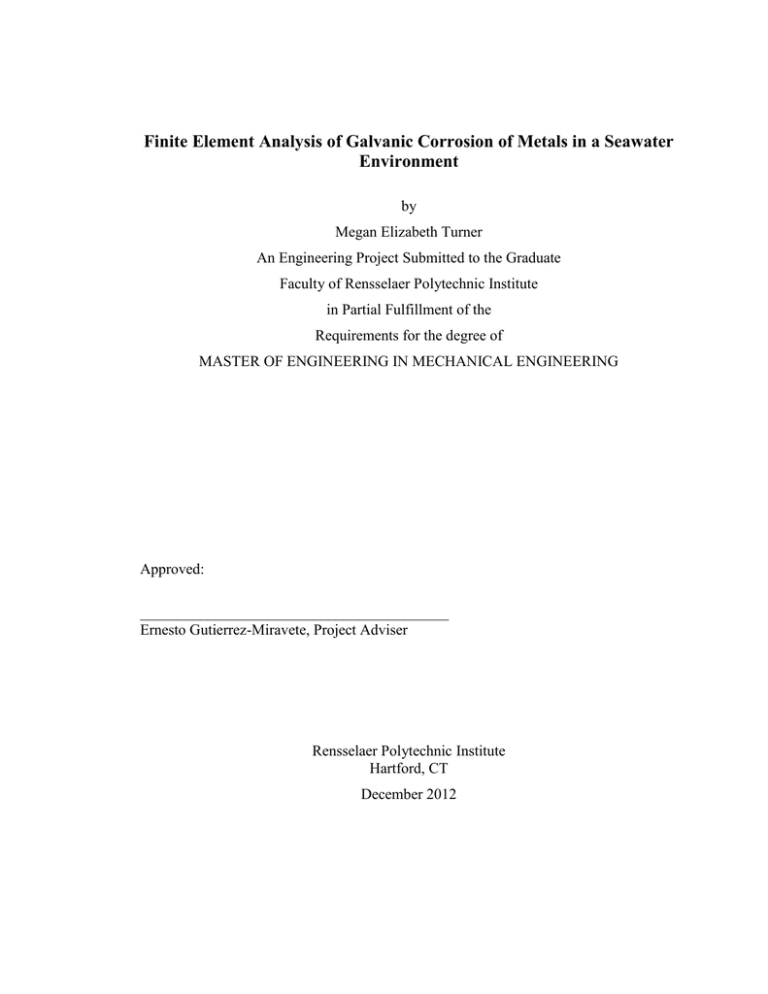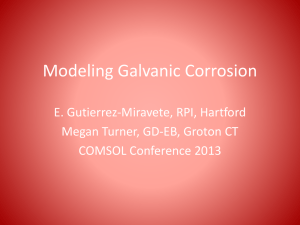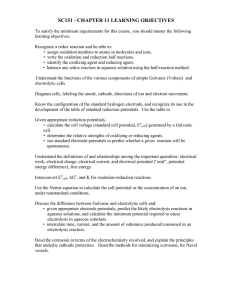Finite Element Analysis of Galvanic Corrosion of Metals in a... Environment
advertisement

Finite Element Analysis of Galvanic Corrosion of Metals in a Seawater Environment by Megan Elizabeth Turner An Engineering Project Submitted to the Graduate Faculty of Rensselaer Polytechnic Institute in Partial Fulfillment of the Requirements for the degree of MASTER OF ENGINEERING IN MECHANICAL ENGINEERING Approved: _________________________________________ Ernesto Gutierrez-Miravete, Project Adviser Rensselaer Polytechnic Institute Hartford, CT December 2012 © Copyright 2012 by Megan Turner All Rights Reserved ii CONTENTS LIST OF TABLES ............................................................................................................ iv LIST OF FIGURES ........................................................................................................... v LIST OF SYMBOLS ........................................................................................................ vi GLOSSARY .................................................................................................................... vii LIST OF KEYWORDS .................................................................................................. viii ACKNOWLEDGMENT .................................................................................................. ix ABSTRACT ...................................................................................................................... x 1. Introduction.................................................................................................................. 1 1.1 Background ........................................................................................................ 1 1.2 Problem Description........................................................................................... 1 1.3 Prior Work.......................................................................................................... 2 2. Methodology ................................................................................................................ 4 2.1 Theory [2]........................................................................................................... 4 2.2 Geometry and Boundary Conditions.................................................................. 4 3. Results and Discussion ................................................................................................ 7 3.1 3.2 COMSOL Model Validation .............................................................................. 7 3.1.1 Using a Linear Expression for Current Density ..................................... 7 3.1.2 Using an Exponential Expression for Current Density .......................... 9 COMSOL Solution for Axisymmetric System ................................................ 11 4. Conclusion ................................................................................................................. 12 5. References.................................................................................................................. 13 6. Appendix A................................................................................................................ 14 iii LIST OF TABLES Table 1: Input Data Used for Model Validation [3] ......................................................... 7 Table 2: Input Data Used for Experimental Model Validation [3] ................................. 10 iv LIST OF FIGURES Figure 1: Simple Coplanar Model Used for Initial Model Validation [3] ........................ 2 Figure 2: Marine Propulsion Unit Analyzed in Reference [6] Study ............................... 3 Figure 3: 2D Cartesian Geometry ..................................................................................... 5 Figure 4: 2D Axisymmetric Geometry ............................................................................. 5 Figure 5: COMSOL Results for Linear Current Density Distribution on the Electrode Surfaces (Surface Plot) ...................................................................................................... 8 Figure 6: Results from Reference [3] ............................................................................... 8 Figure 7: COMSOL Results for Exponential Current Density Distribution on the Electrode Surfaces (Surface Plot) ...................................................................................... 9 Figure 8: Experimental System Used for Model Validation [3]..................................... 10 Figure 9: Axisymmetric COMSOL Results for Exponential Current Density Distribution on the Electrode Surfaces (Surface Plot) ..................................................... 11 Figure 10: COMSOL Results for Linear Current Density Distribution on the Electrode Surfaces (Contour Plot, 20 lines) ..................................................................................... 14 Figure 11: COMSOL Results for Linear Current Density Distribution on the Electrode Surfaces (Contour Plot, 9 lines) ....................................................................................... 14 Figure 12: COMSOL Results for Exponential Current Density Distribution on the Electrode Surfaces (Contour Plot, 20 lines) .................................................................... 15 Figure 13: COMSOL Results for Exponential Current Density Distribution on the Electrode Surfaces (Contour Plot, 9 lines) ...................................................................... 15 v LIST OF SYMBOLS 𝑖 current density (Am-2) 𝑣 reaction rate e- electron 𝑘 rate constant α transfer coefficient (V) ϕ potential (V) ϕ0 equilibrium potential (V) η overpotential (V) 𝑞 charge density E electric field intensity σ conductivity (S/m) vi GLOSSARY Galvanic Corrosion – “…the corrosion that occurs as a result of one metal being in contact with another in a conducting environment” [2] Anode – The portion of a galvanic couple which sees either localized or general metal dissolution [2] Cathode – The portion of a galvanic couple which generally undergoes oxygen reduction (O2 + e- → O2-), or hydrogen evolution (2H+ + 2e- → H2), or both [2] Electrolyte – A solution capable of carrying/transferring charge (Electrochemical) Potential – Measure of the voltage in a system vii LIST OF KEYWORDS Galvanic Corrosion Seawater COMSOL viii ACKNOWLEDGMENT I would like to thank the Rensselaer faculty and staff for their commitment to educating their students. I would especially like to thank Professor Gutierrez-Miravete for the guidance he provided throughout this project. ix ABSTRACT Corrosion is an ever-present problem in all different environments, particularly in marine applications. The goal of this project is to develop a finite element model that can be used with experimental data to characterize the corrosion of a galvanic couple in an electrolyte. This project first addresses a simple system with coplanar electrodes. The finite element model is developed using COMSOL Multiphysics through derivation of equations describing corrosion thermodynamics and electrochemical kinetics. The model is validated through replication of previously determined experimental results and then applied to the study of some system configurations relevant to marine applications. x 1. Introduction 1.1 Background Corrosion is the breakdown of materials, namely metals, through electrochemical reactions within their environment. Corrosion is a consideration in virtually all manufacturing applications. Each year, industries invest time and money into trying to curtail the effects of corrosion. Many different corrosion environments have been studied and monitored to develop corrosion control methods [1]. There are different types of corrosion, including galvanic corrosion. Galvanic corrosion is an electrochemical process that occurs when two dissimilar metals are in electrical contact with one another, and are in a conducting environment known as an electrolyte [2]. Galvanic corrosion is particularly prevalent in marine applications because seawater acts as a naturally free flowing electrolyte. 1.2 Problem Description The amount and rate of corrosion can be correlated to the electrochemical potential distribution within a system. The goal of this project is to develop a finite element model that can be used in conjunction with experimental data to characterize the corrosion of a galvanic couple in an electrolyte. There are a number of factors that can contribute to the amount of corrosion within a system from material factors (e.g. geometry) to environmental factors (e.g. type of electrolyte present) [1]. To limit the effects of all these factors, this project first utilized a simple model of coplanar electrodes as shown in Figure 1. Utilizing a simple geometry allowed the initial focus to be on development of the boundary conditions rather than generation of geometry representing a specific system. 1 Figure 1: Simple Coplanar Model Used for Initial Model Validation [3] 1.3 Prior Work There is a lot of past precedent of scientists taking an interest in corrosion, looking to understand what causes it and what limits or accelerates the process. Numerous studies have been conducted; some take a more global outlook as in Reference [4], whereas some take a more focused approach as in Reference [5]. The study conducted in Reference [4] looked at many different galvanic couples commonly used in seawater applications. The study focused on developing reasonable models for systems experiencing varying periods of exposure. The studies were also conducted under potentiostatic and potentiodynamic scenarios. The potentiostatic experiment allowed for analysis of the corrosion under the natural potentials of the system. While the potentiodynamic experiment introduced potential to the electrodes to analyze the impacts of changing the electrode potential on the corrosion. Other studies sought to analyze corrosion for a specific system geometry and environment. Generally these investigations look to develop methods to prevent or minimize corrosion of that specific system. This is most commonly achieved through a process known as cathodic protection. This process involved introducing an additional part, known as a sacrificial anode, to the system. The sacrificial anode is generally 2 another piece of metal that is introduced into a system so that it will corrode prior to other elements. Reference [5] looked at developing a method to model cathodic protection of a carbon steel pipe in seawater using one or two aluminum sacrificial anodes. Reference [6] looked utilizing a sacrificial zinc anode to cathodically protect the marine propulsion unit shown in Figure 2. Figure 2: Marine Propulsion Unit Analyzed in Reference [6] Study 3 2. Methodology 2.1 Theory [2] The potential distribution within a galvanic solution is fundamentally based on the continuity equation for conservation of charge [2] in the electrolyte. −∇. 𝑖 = In a steady state system, 𝜕𝑞 𝜕𝑡 𝜕𝑞 𝜕𝑡 [1] = 0 and ∇. 𝑖 = 0 The relationship between the electric field intensity and the electric potential is 𝐸 = −∇𝜙 [2] 𝑖 = 𝜎𝐸 [3] and Ohm’s Law is where σ is the conductivity of the electrolyte. From the above, the continuity equation becomes ∇𝜎∇𝜙 = 0 [4] and for uniform isotropic conductivity this yields ∇2 𝜙 = 0 [5] which is Laplace’s Equation for the potential distribution within the electrolyte. 2.2 Geometry and Boundary Conditions The model geometry must be representative of the system being analyzed and must be subjected to appropriate boundary conditions. There are generally three types of boundary conditions that can be considered at electrodes: linear, logarithmic (Tafel) and exponential (Butler-Volmer). This project utilized the finite element program COMSOL Multiphysics to solve Equation [5] for each system. The geometry was developed to represent the system being modeled. During initial model and boundary condition development, simple 2D geometries as shown in Figure 1 and Figure 8 were used. This initial coplanar model 4 was created using a 2D Cartesian geometry as shown in Figure 3. A 2D Axisymmetric geometry was developed, as shown in Figure 4. Figure 3: 2D Cartesian Geometry Figure 4: 2D Axisymmetric Geometry 5 In accordance with Equation [1] at a steady state, it can be assumed that there is no current flow normal to the insulating boundaries [3] because the charge within the system cannot change. This allows for a “Zero Flux” boundary condition to be applied to edges 1-2, 2-3, and 3-4, in Figure 3and Figure 4. Edges 4-5 and 5-1 are the electrode surfaces. The electrode boundary conditions were assigned by using a “Flux/Source” boundary condition for either a linear, logarithmic (Tafel) or exponential (Butler-Volmer) relationship. 6 3. Results and Discussion 3.1 COMSOL Model Validation The geometry that is used in the model reflects the configuration shown in Figure 1. The input data that was used is shown in Table 1 [3]. Table 1: Input Data Used for Model Validation [3] Property Value Units αA anodic reaction of metal A 0.05 V αB anodic reaction of metal B 0.05 V βA cathodic reaction of metal A 0.05 V βB cathodic reaction of metal B 0.05 V C conductivity of the electrolyte 10 Ω-1m-1 𝑖0(𝐴) free current density of metal A 1 Am-2 𝑖0(𝐵) free current density of metal B 1 Am-2 a surface length of metal A 0.01 m b surface length of metal B 0.01 m w thickness of the electrolyte 0.01 m EA free corrosion potential of metal A 0.5 V EB free corrosion potential of metal B -0.5 V Tafel Parameters: 3.1.1 Using a Linear Expression for Current Density Using linear approximations for the current densities at the electrode surfaces produced the potential distribution shown in Figure 10. The COMSOL results correlate qualitatively well to the results in Reference [3], as shown in Figure 6. However, there are discrepancies in the values for the potential within the system. This linear approximation is only appropriate when there is a very small overpotential in the system (generally <0.01V), which is not applicable in this case. The linear approximation gives 7 produces conservative results for the potential distribution. This system is more appropriately represented by an exponential potential distribution within the electrolyte. Figure 5: COMSOL Results for Linear Current Density Distribution on the Electrode Surfaces (Surface Plot) Figure 6: Results from Reference [3] 8 3.1.2 Using an Exponential Expression for Current Density Using exponential approximations for the current densities at the electrode surfaces produced the potential distribution shown in Figure 10. Figure 7: COMSOL Results for Exponential Current Density Distribution on the Electrode Surfaces (Surface Plot) 9 Figure 8: Experimental System Used for Model Validation [3] Table 2: Input Data Used for Experimental Model Validation [3] Property Value Units αCu anodic reaction of Copper 0.001 V αZn anodic reaction of Zinc 0.025 V βA cathodic reaction of Copper 0.05 V βB cathodic reaction of Zinc 0.05 V 0.42 Ω-1m-1 𝑖0(𝐶𝑢) free current density of Copper 1 Am-2 𝑖0(𝑍𝑛) free current density of Zinc 1 Am-2 0.0075 m 0.02 m 0.002 and 0.02 m ECu free corrosion potential of Copper -0.845 V EZn free corrosion potential of Zinc -0.985 V Tafel Parameters: C conductivity of HCl solution a surface length of Copper b surface length of Zinc w thickness of the HCl solution 10 3.2 COMSOL Solution for Axisymmetric System Figure 9: Axisymmetric COMSOL Results for Exponential Current Density Distribution on the Electrode Surfaces (Surface Plot) 11 4. Conclusion Summary of findings Consistency with fundamentals 12 5. References [1] Zhang, X. G. (2011). Galvanic Corrosion. In Uhlig's Corrosion Handbook (Third ed., pp. 123-143). John Wiley & Sons, Inc. [2] Oldfield, J. W. (1988). Electrochemical Theory of Galvanic Corrosion. In H. P. Hack (Ed.), Galvanic Corrosion, ASTM STP 978 (pp. 5-22). Philadelphia, PA: American Society for Testing and Materials. [3] Doig, P., & Flewitt, P. E. (1979). A Finite Difference Numerical Analysis of Galvanic Corrosion for Semi-Infinite Linear Coplanar Electrodes. Journal of The Electrochemical Society , 126 (12), 2057-2063. [4] Hack, H. P., & Scully, J. R. (1986). Galvanic Corrosion Prediction Using Longand Short-Term Polarization Curves. Corrosion , 42 (2), 79-90. [5] Yan, J. F., Pakalapati, S. N., Nguyen, T. V., & White, R. E. (1992). Mathematical Modeling of Cathodic Protection Using the Boundary Element Method with a Nonlinear Polarization Curve. J. Electromchem. Soc. , 139 (7), 1932-1936. [6] Astley, D. J. (1988). Use of the Microcomputer for Calculation of the Distribution of Galvanic Corrosion and Cathodic Protection in Seawater Systems. In H. P. Hack (Ed.), Galvanic Corrosion, ASTM STP 978 (pp. 53-78). Philadelphia, PA: American Society of Testing and Materials. 13 6. Appendix A Additional COMSOL Plots Figure 10: COMSOL Results for Linear Current Density Distribution on the Electrode Surfaces (Contour Plot, 20 lines) Figure 11: COMSOL Results for Linear Current Density Distribution on the Electrode Surfaces (Contour Plot, 9 lines) 14 Figure 12: COMSOL Results for Exponential Current Density Distribution on the Electrode Surfaces (Contour Plot, 20 lines) Figure 13: COMSOL Results for Exponential Current Density Distribution on the Electrode Surfaces (Contour Plot, 9 lines) 15



